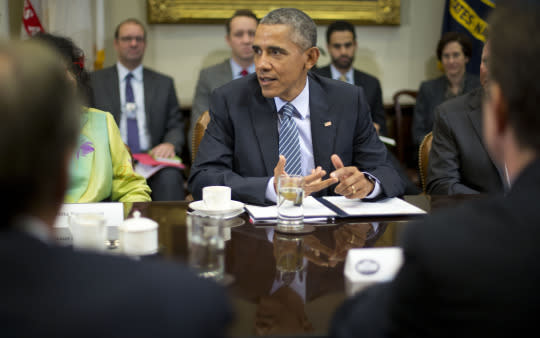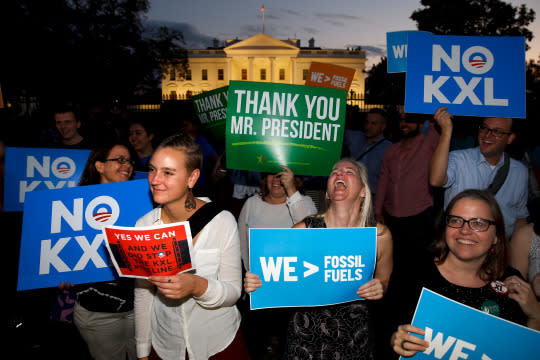Obama’s legacy on climate is at stake in Paris talks

President Barack Obama meets in October with leaders from across the U.S. to discuss climate change. (AP Photo/Pablo Martinez Monsivais)
President Barack Obama heads to a terror-scarred Paris Sunday night to tackle one of the most important priorities of his second term — climate change.
Obama has been laying the groundwork for years ahead of the United Nations’ two-week conference on countering climate change, where nearly 200 countries will be hammering out a pact to cut global emissions of heat-trapping gases. Using executive power, the president has moved the U.S. toward lowering carbon emissions, a key step in building credibility for his efforts to coax China, Brazil and other developing nations to do the same. The Paris conference may help cement his second-term legacy — unless it is overshadowed by terror concerns or sabotaged by Republican opposition to his plans.
Obama’s environmental legacy at this point is mixed. Environmentalists were not enthusiastic about his first term, when health care reform took priority. An effort to pass a cap-and-trade bill for carbon emissions — the Holy Grail of climate change activism — fell apart in 2010. In 2011, Al Gore wrote in Rolling Stone that he was disappointed the president hadn’t brought “change” to the problem of global warming. Though Obama’s stimulus bill included $90 billion in green energy investments, environmentalists were discouraged by the lack of any concrete legislation lowering U.S. emissions.
This all changed in the president’s second term, however, when he told top aides he planned to go big on climate. In June 2013, Obama laid out an ambitious plan to cut emissions from coal-burning power plants and other sources that could be implemented without legislation. “As a president, as a father and as an American, I’m here to say we need to act,” Obama announced in the sweltering heat of a Washington summer. In March, the president told the Huffington Post that getting climate change taken more seriously would be one of the ways he would measure his success as president.
One of Obama’s biggest environmental successes has been in cutting emissions of greenhouse gases during his years in office. The country is now on track to cut its greenhouse gas pollution by 17 percent by 2020 compared with 2005 levels, the original goal set by the failed cap-and-trade legislation. This progress is driven in part by market forces Obama had nothing to do with — the recession and surge in availability of cheap natural gas — but also the growing popularity of green energy sources. In the past few years, the president has also used existing environmental legislation passed under Richard M. Nixon to force new coal plants to curb their emissions. He has also tightened fuel, vehicle and appliance efficiency standards, all without the help of Congress, which opposes his environmental agenda.
But it’s unclear if the president will be remembered for his actions on the environment, especially given that executive action — an easier legacy to erase than legislation — can be reversed by the next president. “He’s coming back to an issue he really cares about,” says Julian Zelizer, a political history professor at Princeton University. “He’s not doing it through legislative action but through executive action, which is more precarious and I think in some ways has less political impact than a bill.”

Activists celebrate the Obama administration’s rejection of the Keystone XL pipeline outside the White House on Nov. 6. (Reuters/Jonathan Ernst)
But a big global agreement at Paris would be much harder for a future president to erase. And the progress on cutting greenhouse gas emissions at home gives the president more credibility to ask other countries to cut their emissions, reversing the decades-long trend of the U.S. lecturing developing countries on pollution while continuing to release more and more carbon dioxide into the air. Earlier this month, the president also rejected the Keystone XL pipeline project to transport tar sands from Canada to the Gulf Coast, a project environmentalists fiercely opposed.
“For almost 20 years now, the single biggest barrier to getting international agreement [on emissions cuts] is the fact that the U.S. isn’t prepared at home to act aggressively on climate change,” said Jake Schmidt, director of the international program at the Natural Resources Defense Council.
That has changed now, but Obama still faces fierce resistance from the Republican-controlled House. The House is set to debate as early as Tuesday a resolution opposing the Environmental Protection Agency’s new greenhouse gas regulations for power plants, called the Clean Power Plan, which passed the Senate last week. There’s also a Republican movement to block allocations for the U.N.’s Green Climate Fund, which gives billions of dollars to developing nations to curb emissions. The president could veto these measures, but the attack could still raise “confusion” among other countries about whether the president can follow through on his climate agenda, according to Schmidt.
This opposition, as well as the intense focus on how to stop ISIS terror attacks, threatens to overshadow the president’s diplomatic achievements on the environment. In a call with reporters, national security adviser Ben Rhodes said the president will discuss counter-ISIS initiatives with French President Francois Hollande during his visit. Obama may participate in an event to pay tribute to the people of Paris as well.
“President Obama is focused on achieving outcomes here that will endure long after whatever the focus of the day is,” Rhodes said.
The president has been preparing for years for this conference, taking the opportunity at nearly every single meeting with international leaders to push them on the upcoming climate deal. Obama has especially worked on China, India and Brazil, coaxing them into agreeing to more action on emissions than ever before. China, the world’s largest polluter, agreed to peak its emissions by 2030. In Paris, countries will propose targets for 2020 and beyond, with the goal of bringing emissions down even more steeply in the future.
As of now, even the most ambitious plans on the table would not avoid a warming of 2 degrees Celsius by the end of the century, a figure that scientists have pegged as the point at which climate change will create extreme and serious global damage. If the president were to help hammer out a deal that brought global emissions below that level, the accord could secure his environmental legacy.
“To some degree, the culmination of all of those actions at home is getting the rest of the world to act on climate change as well,” said John Coequyt, the Sierra Club’s global climate policy director.
Ultimately, Obama can’t control what other countries do. All he can do is lead by example — and hope that, unlike his opponents at home, his counterparts from around the world understand what is at stake.

